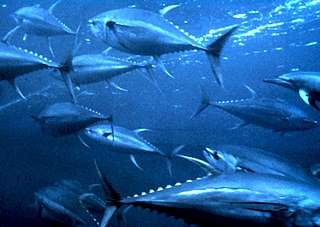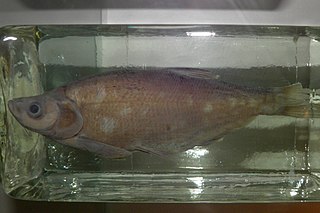
Herring are various species of forage fish, belonging to the order Clupeiformes.

Sardine and pilchard are common names for various species of small, oily forage fish in the herring suborder Clupeoidei. The term 'sardine' was first used in English during the early 15th century; a somewhat dubious etymology says it comes from the Italian island of Sardinia, around which sardines were once supposedly abundant.
Siberian taimen, also known as the common taimen, Siberian giant trout or Siberian salmon, is a species of salmon-like ray-finned fish from the genus Hucho in the family Salmonidae. These fish are found in rivers in Siberia and adjacent regions, and are harvested throughout the year.

The Mongolian finch, also known as the Mongolian trumpeter finch, is a small passerine bird in the finch family Fringillidae.

Thunnus is a genus of ocean-dwelling, ray-finned bony fish from the mackerel family, Scombridae. More specifically, Thunnus is one of five genera which make up the tribe Thunnini – a tribe that is collectively known as the tunas. Also called the true tunas or real tunas, Thunnus consists of eight species of tuna, divided into two subgenera.

Chanodichthys is a genus of freshwater ray-finned fishes belonging to the family Xenocyprididae, the East Asian minnows or sharpbellies. The species in this genus are found in Eastern Asia. The name is derived from the Greek word chanos, meaning "abyss, mouth opened, inmensity", and the Greek word ichthys, meaning "fish". Chanodichthys is closely related to Culter and some species have been moved between these genera.

The sharpbelly or wild carp, sharpbelly, or common sawbelly, is a tropical freshwater and brackish water fish belonging to the Cultrinae subfamily of the family Cyprinidae. It originates in large streams and reservoirs in China, Taiwan, Japan, Hong Kong, Korea, and the Amur River basin. It has become established as an exotic species in several other countries, including Iran, Afghanistan, and the former Soviet Union, where it has displaced local species. It was originally described as Culter leucisculus by S. Basilewsky in 1855, and has also been referred to as Chanodichthys leucisculus and Hemiculter leucisculus warpachowskii in scientific literature.
The Mongolian vole is a species of rodent in the family Cricetidae. It is found in China, Mongolia, and Russia.

An anchovy is a small, common forage fish of the family Engraulidae. Most species are found in marine waters, but several will enter brackish water, and some in South America are restricted to fresh water.
Anabarilius transmontanus is a species of freshwater ray-finned fish belonging to the family Xenocyprididae, the East Asian minnows or sharpbellies. It is known from the Red River and Pearl River drainages in Yunnan, China; it is expected to occur in northern Vietnam. It can grow to 16 cm (6.3 in) total length, although it is commonly around 10 cm (3.9 in) standard length. It occurs in both rivers and lakes. The species is threatened by domestic and urban water pollution, habitat loss, and possibly non-native species.
Chanodichthys abramoides is a species of ray-finned fish belonging to the family Xenocyprididae, the East Asian minnows or sharpbellies. This fish is is endemic to the southern part of the lower Amur river system, including the Sungari and Ussuririvers and Lake Khanka, in Heilongjiang and Jilin provinces in China and in Amur. Primorsky Krai and Khabarovsk Krai districts in Russia.
Chanodichthys dabryi, the humpback or lake skygazer, is a species of ray-finned fish in the genus Chanodichthys. This freshwater species belongs to the family Xenocyprididae. The humpback is found in China and Russia where it ranges from the Amur River to the Yangtze. It is fished, but remains common. As presently defined, it is likely species complex. It reaches 42 cm in length and 700 g (1.5 lb) in weight.
Chanodichthys flavipinnis is a species of freshwater ray-finned fish belonging to the family Xenocyprididae, the East Asian minnows or sharpbellies. This species is endemic to Vietnam.
Chanodichthys oxycephalus is a species of freshwater ray-finned fish belonging to the family Xenocyprididae. This species occurs in the Amur and Yangtze river basins in eastern Russia, Korea and China.

The predatory carp, also known as the redfin culter or skygazer, is a species of ray-finned fish belonging to the family Xenocyprididae, the East Asian minnows or sharpbellies. This species ranges from the Amur River south to Taiwan and the Red River, as well as Lake Buir in Mongolia. It reaches 102 cm in length and 9 kg in weight.

Culter alburnus, the topmouth culter, is an East Asian species of freshwater ray-finned fish genus Culter, this belongs to the family Xenocyprididae.
Culter recurviceps is a species of freshwater ray-finned fish belonging to the family Xenocyprididae. This species occurs in the Pearl River and Hainan in southern China.
Sinogastromyzon tonkinensis is a species of ray-finned fish in the genus Sinogastromyzon. It is endemic to the Red River drainage in northern Vietnam and Yunnan, southern China. It grows to 3.8 cm (1.5 in) SL. Very little is known about ecology of this species that is used in some subsistence fisheries.
Kessler's sculpin is a species of Baikal sculpin, a freshwater fish native to Russia and Mongolia where it occurs in Lake Baikal and surrounding lakes as well as the Selenga, Angara and Bain Gol rivers. It is the only member of its genus. In Lake Baikal it occurs on sandy, rocky-sandy or sandy-muddy bottoms, ranging from relatively shallow water to depths of 70 m (230 ft). In rivers they mainly occur in slow-flowing channels and floodplains.
Cottus szanaga is a species of freshwater ray-finned fish belonging to the family Cottidae, the typical sculpins. It is found in Mongolia and Russia. It reaches a maximum length of 8.2 cm. This species was first formally described in 1869 by the Polish naturalist Benedykt Dybowski with its type locality given as the Onon River in the Amur River drainage basin of Russia. The specific name szanaga is derived from Szanaga-sagasu, meaning "spoon fish" the Buryat dialect word for this fish n the Amur basin.









